Last updated on December 10, 2023

Yotian Tactician | Illustration by Fariba Khamseh
Greetings planeswalkers! With The Brothers’ War dropping I wanted to have an early guide up for everyone playing prerelease this weekend.
My upcoming full Draft guide will have more details, but for now I want to cover everything I can without having actually touched the set directly. Let’s dig in!
Format Mechanics
Prototype
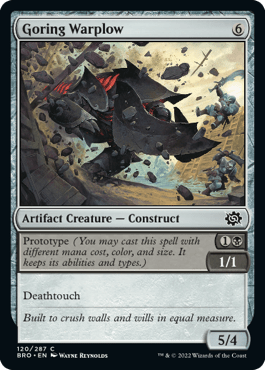
Prototype is the only new mechanic introduced in The Brothers’ War. It’s an alternate cost that appears on 18 colorless artifact creatures. Creatures with prototype can be cast as a different mana cost, color, and size, but the creature’s abilities and types remain unchanged.
All of the prototype costs in this set are cheaper than the base cost of the creature, and they all require some form of colored mana. Every color but white has at least one common with the mechanic while black has the fewest prototype cards (just two) and green has the most (six with two at common rarity).
Prototype serves a number of purposes in this Limited environment:
- Prototype cards are flexible because they basically act like two cards in one if you’re able to pay their prototype costs. For example, Goring Warplow can be roughly either Typhoid Rats or Feral Abomination, giving it value both early in the game and later on.
- Prototype lets you get away with playing more big colorless artifacts for your Powerstones (more on them later) and fat artifact payoffs like Arms Race.
- Prototype introduces some notable tensions in deckbuilding because it appears exclusively on colorless artifacts.
- There’s nothing stopping you from just playing Combat Thresher exclusively as a 7-drop in your Simic () deck. You won’t have the same flexibility that a white deck would but it’s still a strong card that works well with Battery Bearer.
Unearth

Unearth is a returning mechanic that hasn’t been seen in Standard since Alara Reborn. It’s an activated ability seen on artifacts and creatures that lets you pay a cost to return them from the graveyard to the battlefield. Once returned the permanent gains haste and “exile this at the beginning of the next end step.” Keep in mind that unearthed permanents also get a replacement effect to exile them if they’d otherwise leave the battlefield in any way.
Unearth appears on 20 colorless artifacts in The Brothers’ War, only two of which aren’t creatures (Mishra's Research Desk and Mask of the Jadecrafter). It’s similar to prototype in that all of the cards with unearth are colorless, and every one of them but Reconstructed Thopter and Cityscape Leveler has a colored unearth cost. Every color but green has at least one common with the mechanic. Blue has the fewest unearth cards (just two) while red has the most (six with two at common rarity).
Unearth fills a number of purposes in this set:
- Unearth is one of several mana sinks in the set, giving you something to do later in the game if you run out of cards to play. You can even use Powerstones to pay for unearth costs.
- Unearth can be an aggressive mechanic since unearthed creatures have haste and might just provide that extra attacker you need to end a game.
- Unearth can also be played for value, either inherently (Scrapwork Rager) or when paired with sacrifice outlets like Thraxodemon and Powerstone Fracture.
- Unearth provides a way to get extra value from self-mill and discard cards like Bitter Reunion and Tomakul Scrapsmith.
One final note on unearth is that it also has two cards that specifically reference the mechanic: Meticulous Excavation and Mishra, Tamer of Mak Fawa. Mishra grants unearth to each artifact in your graveyard while Meticulous Excavation lets you directly rebuy unearthed creatures if you have enough mana.
Powerstones
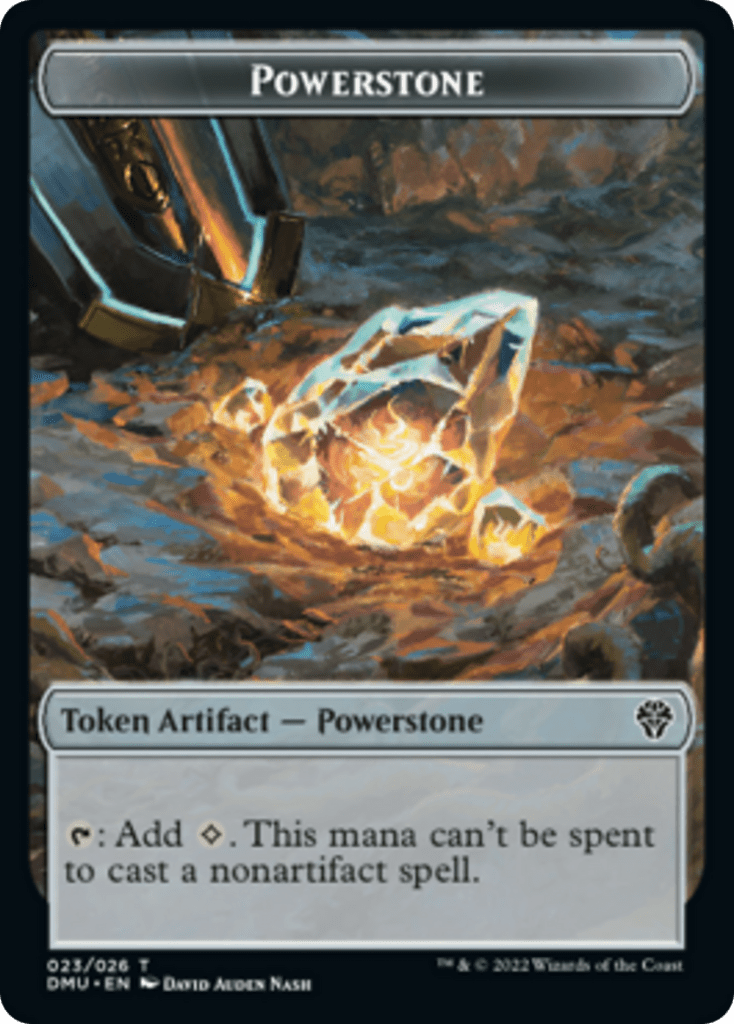
Powerstones are a type of artifact token introduced in Dominaria United by Karn, Living Legacy. They’re a restrictive mana source that can tap to add one colorless mana that can’t be used to cast nonartifact spells.
Though their role in the last set was a footnote at best, Powerstones are positioned to be a core mechanic in The Brothers’ War. Each color has at least one common that creates them, and there are 26 total cards in the set that do so. They’re often received as bonuses on otherwise normal Limited spells like Sibling Rivalry (Act of Treason) and Gix's Caress (Dark Inquiry).
Powerstones pair well with expensive artifacts, and you can also use them to pay unearth costs and activated abilities from cards like Supply Drop, Goblin Firebomb, and Thraxodemon. They also have some use as artifact fodder for cards like Penregon Strongbull, Powerstone Fracture, and Thraxodemon.
Powerstones are a core “currency” of this set, though certain archetypes value them less than others, like Azorius () soldiers, Boros () aggro, and Dimir () draw two.
Meld

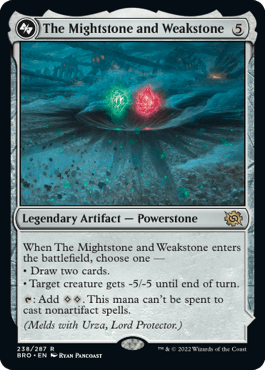
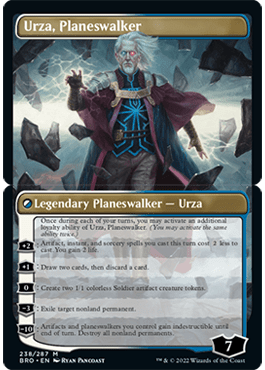
Meld is another returning mechanic that was first seen in Eldritch Moon. Meld is a splashy mechanic that allows you to physically combine two cards into one uber powerful card. The conditions for doing this will always be owning/controlling two unique cards and doing something specific that they ask of you.
Meld appears on six cards in The Brothers’ War for a total of three meld pairs, each of which is formed by a mythic and a rare. The three pairs, their conditions for melding, and their associated payoff form are:
- Own and control Titania, Voice of Gaea and Argoth, Sanctum of Nature, untap with both and four or more land cards in your graveyard to meld into Titania, Gaea Incarnate.
- Own and control Urza, Lord Protector and The Mightstone and Weakstone, pay seven to activate Urza at sorcery speed to meld them into Urza, Planeswalker.
- Own and control Mishra, Claimed by Gix and Phyrexian Dragon Engine, attack with both to meld them into Mishra, Lost to Phyrexia.
I wouldn’t expect to meld often in Limited thanks to the rarity of the cards and their overall finickiness. You could realistically draft The Brothers’ War 50 times and never pull off any of these pairings. All the cards are individually pretty good rares, so if you’re lucky enough to open or draft the pairs here then totally go for it!
Format Summary
Artifact Focus
The Brothers’ War is a very artifact-focused set with some old wrinkles thrown in. A lot of the cards in this set care directly about artifacts and reward you for including them in your deck. There are no vehicles and only one colored artifact (The Temporal Artifact) to keep a “retro feel.”
A lot of the artifacts in this set are expensive but should be surprisingly castable thanks to the prototype and Powerstone mechanics.
Retro Artifacts
The most significant old wrinkle you’ll see in this set are Retro Artifacts, which greatly resemble the Mystical Archive from Strixhaven. Every draft pack of The Brothers’ War you open will have at least one Retro Artifact in it, which pulls from a pool of 63 available reprints.
The quality on these varies wildly from unplayable (Ivory Tower) to broken (Wurmcoil Engine), plus many cards in between.
Expected Speed
The Brothers’ War’s format is going to be slow… probably. The implied core gameplay loop of Powerstones to giant robots certainly isn’t aggressive, but that loop doesn’t speak for every archetype. A lot of the 2-color pairs want to attack and there are a lot of pump spells in the set.
I’d default to building greedy Sealed pools but also include good value creatures like Fallaji Archaeologist, Thraxodemon, and Blanchwood Prowler when possible. Expect to play 16 to 18 lands depending on your curve. High-curve decks will have Stern Lesson and other Powerstone generators so they’re unlikely to play anything above 18.
Top Commons
White
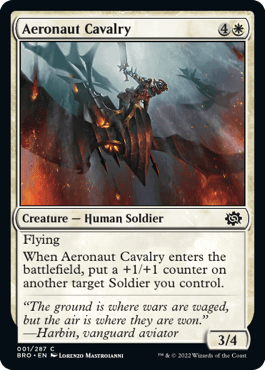
Aeronaut Cavalry is an efficient curve topper, a Skyswirl Harrier variant, and an easy-to-use upside.
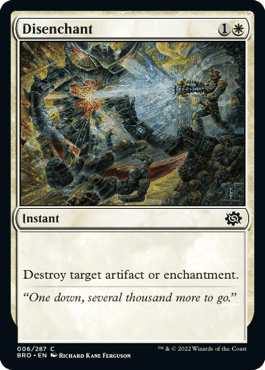
Disenchant is premium removal in an artifact set. It’s cheap and instant for blowouts and trading up.
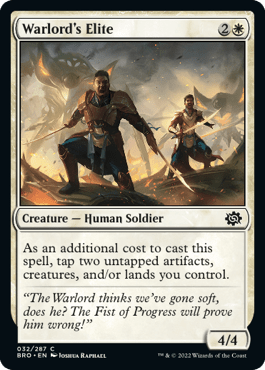
Warlord's Elite (is a soldier with a fair flexible rate, good sizing, plus it costs three for “mana value 3 or less” payoffs.
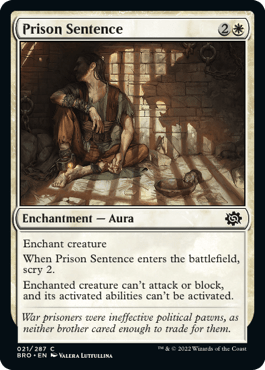
Prison Sentence is scry 2 on Arrest and amazing at common, plus it’s highly recommended though it’s vulnerable to sac and bounce.
Blue
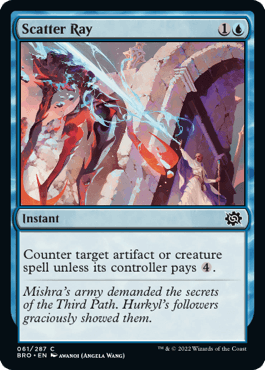
Scatter Ray is good early interaction that can still work against expensive robots later.

Fallaji Archaeologist is another good value card that blocks well for its cost or cantrips.
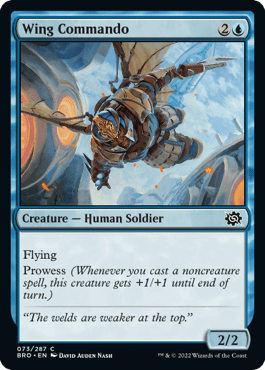
Wing Commando is Wind Drake with prowess, and it’s also a soldier.
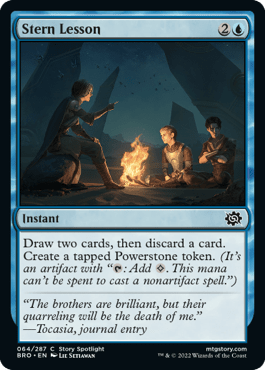
Stern Lesson is a great value card that helps ramp into artifacts, fixes mana problems, and triggers “draw two” payoffs.
Black

If the format or particular matchup is fast then you really can do no better than Disfigure. It’s still a combat trick against bigger creatures too.

I’m going to take a risk by recommending a discard spell in Limited for once, but Gix's Caress should perform well if the format or particular matchup isn’t very fast.
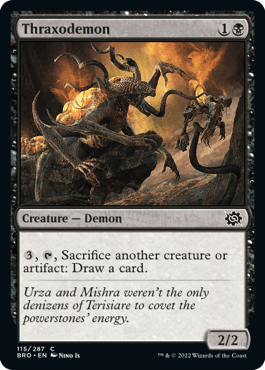
Thraxodemon is clunky to activate but is a bear with great upside, so I think it’ll be sought after.
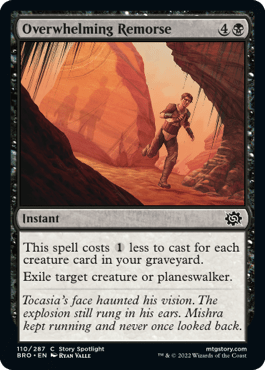
Overwhelming Remorse is the best common removal in the set. It only needs to cost one less for a good rate and becomes insanely efficient with self-mill and trading creatures.
Red

Conscripted Infantry is a decent value creature of sorts with 3 power. Trading this off with other 2- and 3-drops puts you slightly ahead.
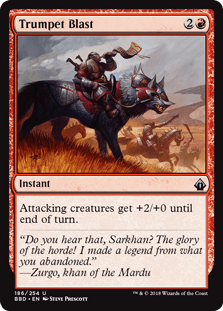
Even at four mana Trumpet Blast is a much more appealing card when it comes with a “I don’t have a board” mode, which makes Mishra's Onslaught a good red common.
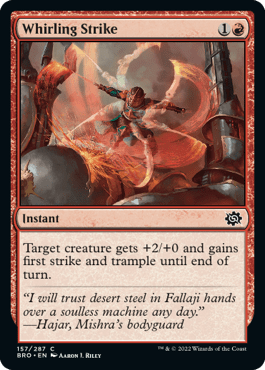
Whirling Strike is one of the best tricks in the set. It pushes extra damage and should win most combats.
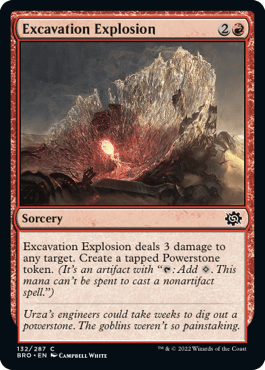
Excavation Explosion is the best red common by a considerable margin since it’s efficient removal with upside that can go to the face if needed.
Green

Argothian Opportunist is an efficient creature for any deck that cares about ramping and artifacts, which is every green-based deck except Golgari ().
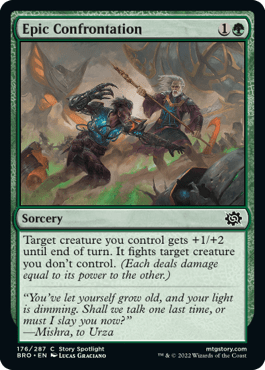
Epic Confrontation is green’s only removal spell and it’s risky, but the extra sizing makes this safer than the average Prey Upon or Pounce variant.
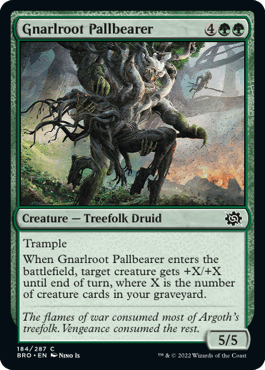
Gnarlroot Pallbearer seems substantially better positioned than Vigorspore Wurm thanks to a superior supporting cast and should be a great curve topper.
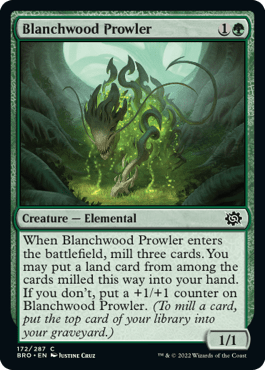
Blanchwood Prowler is the best of its cycle. It gives me Satyr Wayfinder vibes in a set that has lots of uses for self-mill.
Number of Colors
This set isn’t shaping up to be a very colorful one, especially compared to Dominaria United. Powerstones add only colorless mana and most of the cards in the set are mono-colored or colorless. Expect most decks to be two colors, or even just one color plus a splash.
There’s only one 3-color card in the set (Tocasia, Dig Site Mentor). It’s a great creature and should be one of the more common splashes.
Fixers
Splashing is still possible in this set, but your options are limited. Use these cards to help add that splash or third color:

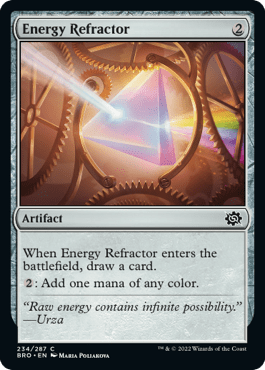
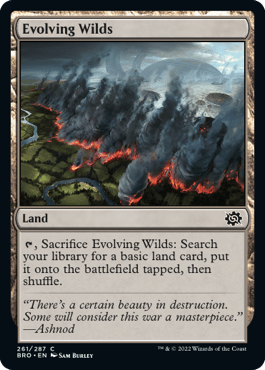
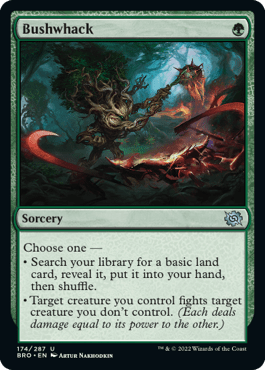
- Citanul Stalwart is a useless body on its own, so make sure you have other cheap creatures and artifacts to tap with it.
- Energy Refractor is a decent all-purpose fixer/cantrip, but you do overpay for cards with it.
- Evolving Wilds is the best common for fixing mana.
- Bushwhack is basically just Lay of the Land mixed with Prey Upon.
You can also get some extra help from a couple of the Retro Artifacts, though these are rarer to open so don’t bet on them:
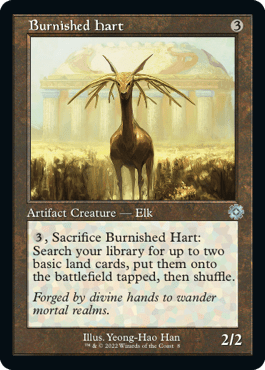


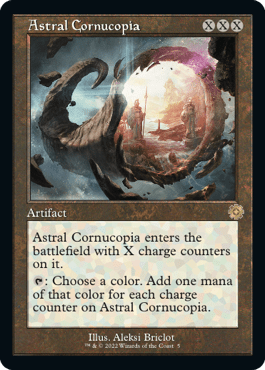
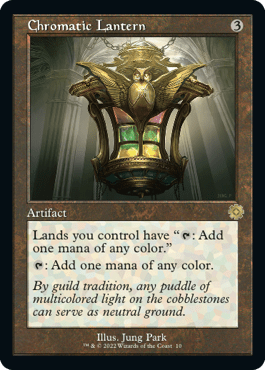

Cards Worth Splashing
The best cards to splash are single-pip bombs and premium removal spells. The fixing in this set won’t be sufficient to splash double-pip bombs like Teferi, Temporal Pilgrim or Tyrant of Kher Ridges. Here’s a non-exhaustive list of bombs I suggest you consider splashing:
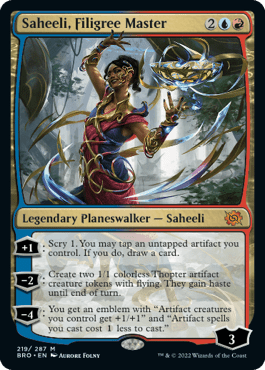

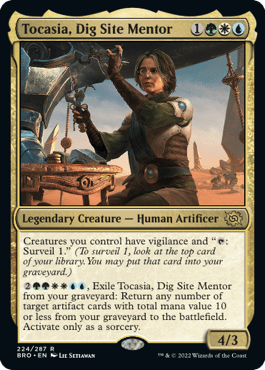


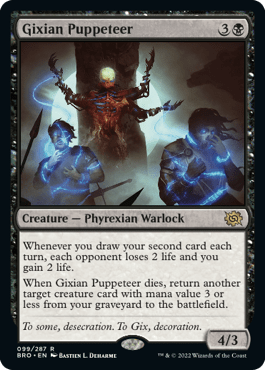
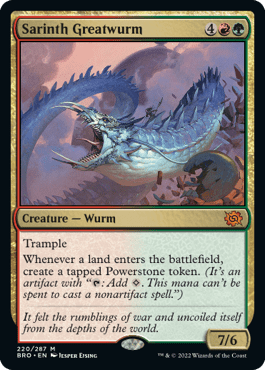
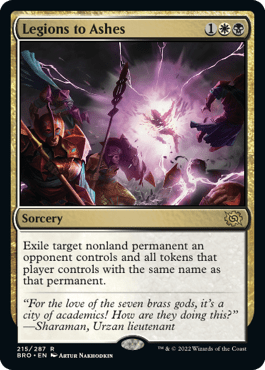
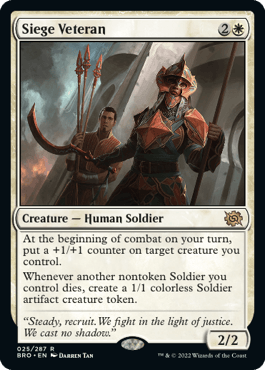
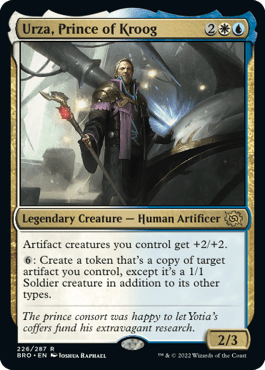
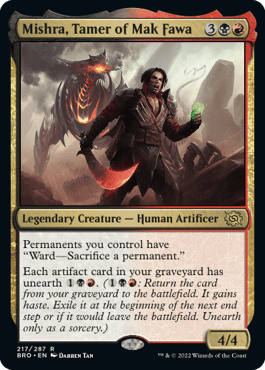

- Saheeli, Filigree Master
- Mishra, Claimed by Gix
- Tocasia, Dig Site Mentor
- Skystrike Officer
- Myrel, Shield of Argive
- Gixian Puppeteer
- Sarinth Greatwurm
- Legions to Ashes
- Siege Veteran
- Urza, Prince of Kroog
- Mishra, Tamer of Mak Fawa
- Loran of the Third Path
Sweepers

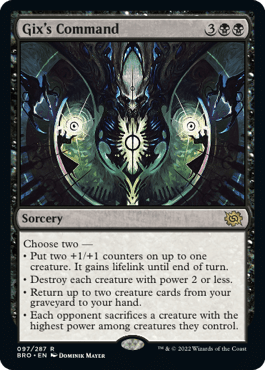
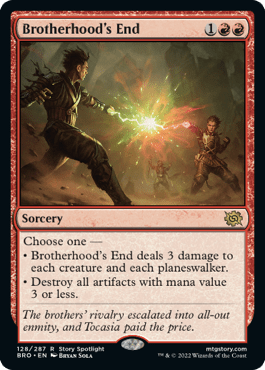

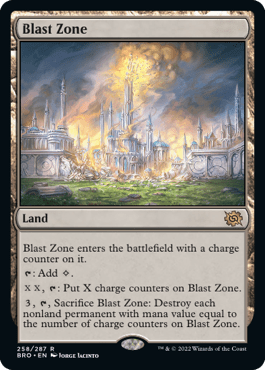
If you’re obsessed with playing around everything like I am then it’s good to know what sweepers are in each set. The Brothers’ War has a handful of rare sweepers and two uncommons capable of killing masses of X/1s (Gruesome Realization and The Fall of Kroog).
Most of these sweepers are somewhat conditional, and Urza's Sylex will either be telegraphed or cost seven mana. It’s probably a good idea to try to beat the odds and play to the board in game one, unless you’re extremely ahead.
Cycles
I’ve mentioned this in other guides, but one of the better ways to get a feel for a new set is by studying its cycles. Cycles take up a significant chunk of a lot of set’s retail and can teach you a lot about core Limited gameplay patterns.
There actually aren’t many cycles in this set, but let’s see if we can learn anything from the few that exist.
Common Self-Mill Creatures



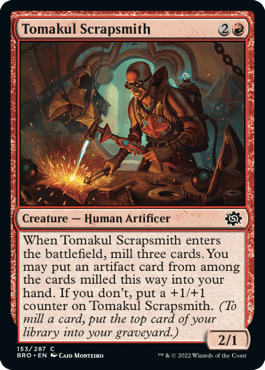

This is a common cycle of creatures that help fill your graveyard for unearth and ”number of creatures in your graveyard” value. The restrictions on each of these creatures correspond to their color identities in this format.
Fallaji Archaeologist and Blanchwood Prowler seem like the best cards in the cycle since they both cost just two mana and cantrip by noncreatures. This is optimal given that both forms of graveyard value in this set come from creatures.
Common Urzatron Workers
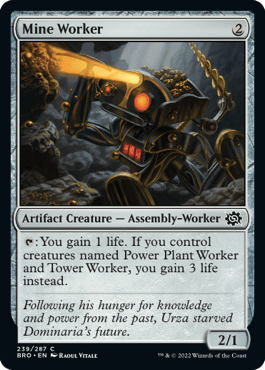
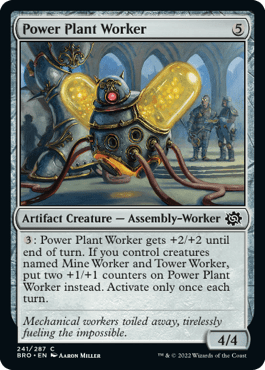
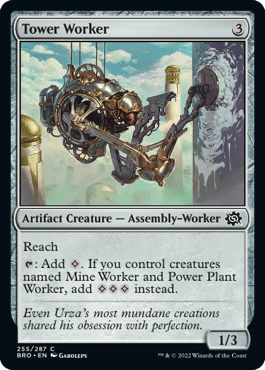
This is a cheeky cycle of common creatures that harkens back to the classic Urzatron lands. These are curve-filler artifact creatures on their own and are neither unplayable nor particularly great. They become much better if you can get all three out at once, especially Power Plant Worker.
I’d probably play the others if I had them and was playing one to fill my curve but wouldn’t prioritize these anywhere.
Uncommon Mono-Color Payoffs
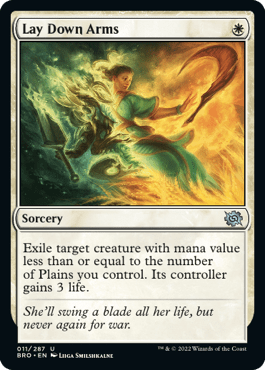


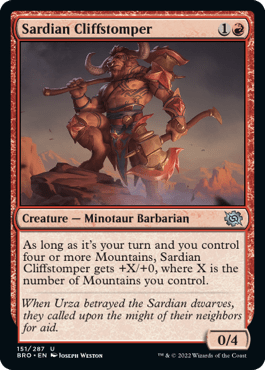

This is an uncommon cycle that pays you off for being mono-color, or at least as close to it as you can be (i.e., 14 Swamps, 3 Plains for Corrupt, and 1-2 white cards). These are all great if you’re mono-color, and mediocre at best with a standard 9/8 mana split.
There aren’t a lot of other mono-color payoffs, just Steel Exemplar.
Uncommon 2-Color Signposts
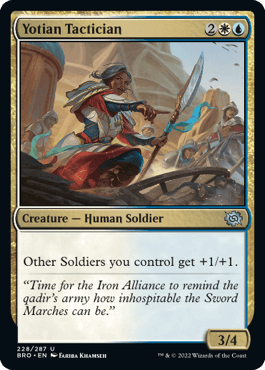

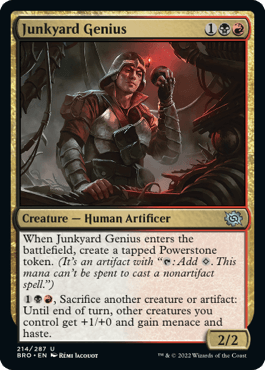
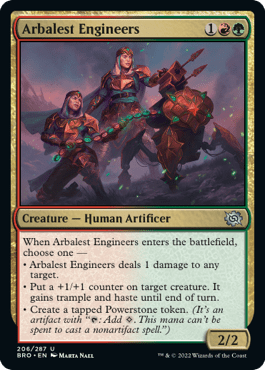
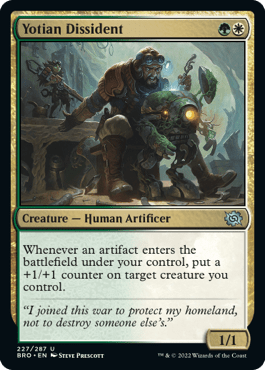
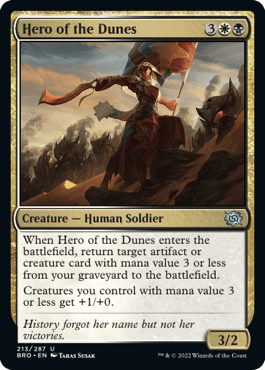
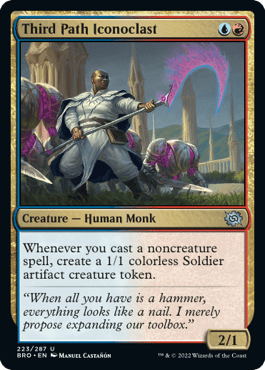
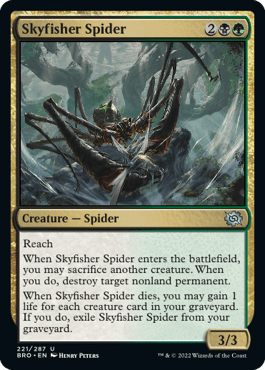
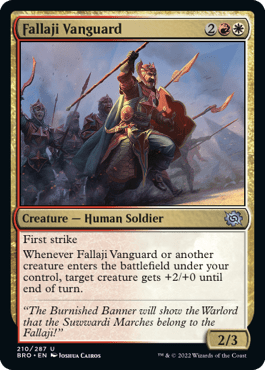
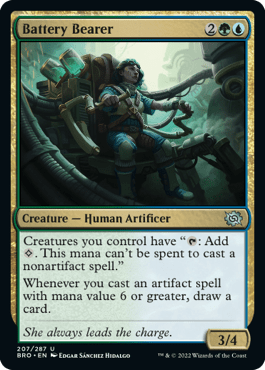
- Yotian Tactician
- Evangel of Synthesis
- Junkyard Genius
- Arbalest Engineers
- Yotian Dissident
- Hero of the Dunes
- Third Path Iconoclast
- Skyfisher Spider
- Fallaji Vanguard
- Battery Bearer
This is a standard uncommon cycle that shows off supported 2-color archetypes for you to build around. These are rather prescriptive for how your decks might look given that The Brothers’ War doesn’t support a great deal of splashing.
Rare Commands

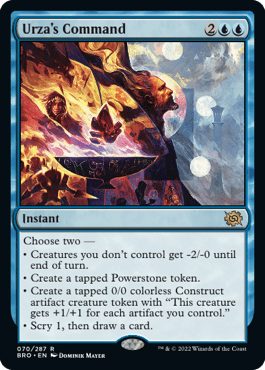

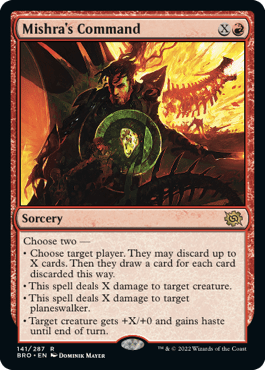
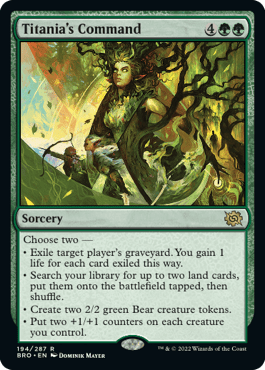
These are powerful and flexible rares, most of which I expect to P1P1 when I open them. The best of the cycle is easily Titania's Command (hint: choose two bears and +2/+2 counters on everything), but none of them are bad. Urza's Command is the only instant of this command cycle.
Urza and Mishra Cards



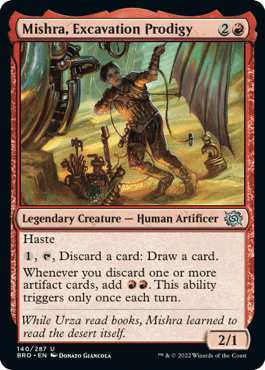


- Urza, Powerstone Prodigy
- Urza, Prince of Kroog
- Urza, Lord Protector
- Mishra, Excavation Prodigy
- Mishra, Tamer of Mak Fawa
- Mishra, Claimed by Gix
The iconic brothers behind this war get not one, not two, but three printings in this set alone! All of these cards happen to be pretty good too. The uncommon variants are nice value looters, and the rares and mythics range from solid to great 2-color payoffs.
There’s also nothing stopping you from having all three Urzas or Mishras out at once since the legend rule only applies to permanents that share the exact same name. Pretty neat!
2-Color Archetypes
Azorius Soldiers

Yotian Tactician headlines this aggressive soldier tribal deck, an unusual strategy for Azorius to say the least. There are a lot of soldiers in this set, most of which are white.
Most of the strong payoffs for doing soldier tribal appear at higher rarities, so I wouldn’t expect every single Azorius deck to maximize this theme.
Dimir Draw Two

Evangel of Synthesis shows off Dimir’s theme in The Brothers’ War, which is a repeat of Throne of Eldraine’s Izzet () archetype.
There aren’t too many payoffs for this one. Gixian Puppeteer, Evangel of Synthesis, Thopter Mechanic, Gurgling Anointer, Lat-Nam Adept, and Trench Stalker are all that’s out there. But the good news is that drawing extra cards is already a great thing to do, so building around these creatures is hardly a big request.
Rakdos Sacrifice/Unearth

Junkyard Genius is Rakdos’ () signpost uncommon in this set. Rakdos is fairly open ended here since you can play it as an aggro deck, a classic steal and sac strategy (Sibling Rivalry plus Powerstone Fracture), or a midrange/artifact deck. Junkyard Genius just so happens to be good in all three of those strategies.
Rakdos is notably pretty great at leveraging unearth for extra sac fodder or deadly alpha strikes.
Gruul Midrange/Ramp

Arbalest Engineers is a supremely flexible card that shows off Gruul’s () approach to this set.
It’s namely a bit of a mixed bag: you can attack, ramp to artifact fatties with Powerstones, or do a bit of both. Either way you’ll want to prize Arbalest Engineers highly because it looks like one of the best uncommons in the set.
Selesnya Artifacts

Yotian Dissident showcases a nifty Selesnya () artifact deck of sorts. Cards like Yotian Dissident, Sarinth Steelseeker, and Thopter Architect reward you for repeatedly playing artifacts.
Powerstones, Mass Production, and Scrapwork Cohort can be great fits since quantity matters more than quality in this case.
Orzhov Midrange/3-Cost Matters

Hero of the Dunes leads an aggressive Orzhov () deck built around playing cheap creatures for benefits. Orzhov-adjacent cards like Hero of the Dunes, Recommission, and Tocasia's Welcome work best if you include lots of creatures with mana value three or less.
Warlord's Elite is a top-notch inclusion here as a “5-drop” that doesn’t actually cost five, letting you play a big creature without giving up bonuses.
Izzet Noncreatures Matter

Third Path Iconoclast offers the latest in Young Pyromancer technology. It offers a wrinkle on Izzet’s usual spellslinger gameplay by including benefits for artifacts and enchantments.
Expect to build control and tempo decks with a focus on card advantage, removal, and lower creature counts in Izzet in this set. The few creatures I’d want to play are Third Path Iconoclast, Fallaji Archaeologist, and a couple artifact fatties for the late game.
Golgari Graveyard

Skyfisher Spider brings the undergrowth mechanic back for another run, albeit not by name. Filling your graveyard is much easier in this set than it was in Guilds of Ravnica since there are a lot of competent commons for that purpose.
Blanchwood Prowler is a favorite enabler while Gaea's Courser and Overwhelming Remorse are some of the better payoffs.
Boros Aggro

Fallaji Vanguard wants to do what Boros does in every set: turn sideways with some friends! There isn’t much flickering in The Brothers’ War, so maximizing this is mostly about playing a high creature count and keeping the pressure up.
Having some extra unearth for more triggers and alpha strikes won’t hurt. Note that this and Hero of the Dunes are soldiers, so sometimes Azorius soldier tribal payoffs can work well in Orzhov and Boros.
Simic Powerstone Ramp

Battery Bearer helps Simic () occupy a similar space it does in a lot of sets as the “biggest” of the 10 2-color pairs. This is an amazing ramp payoff that feeds you extra cards and mana for your aspiring Gundams like Rust Goliath and Depth Charge Colossus.
Simic uses Powerstones better than just about any 2-color pair in the format.
Format-Specific Sealed Tips and Combos
Here are some cute combos for you to try that I’ve thought of while poring over the spoilers for The Brothers’ War:
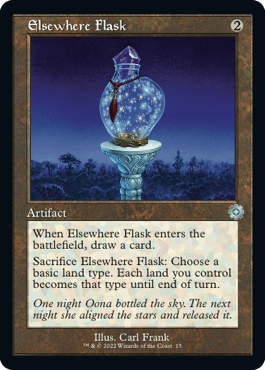

Elsewhere Flask is a mediocre cantrip that combos with any of the mono-color payoff cards. Corrupt and Elsewhere Flask are particularly brutal, but Flask is easy enough to run that I like it with the entire cycle.

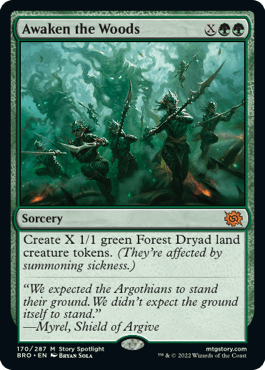
Blanchwood Armor has another combo in the set with Awaken the Woods. Don’t forget that the 1/1 creatures you create are Forests!




Mightstone's Animation is an efficient creature of sorts, but you’ll need Powerstones and cantrips like Elsewhere Flask and Ichor Wellspring otherwise it’s a dead card.
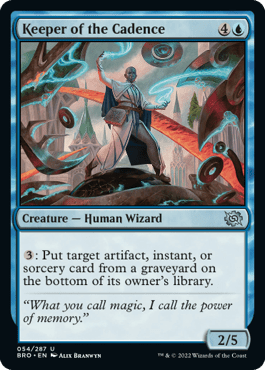
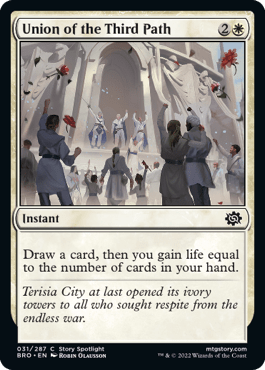
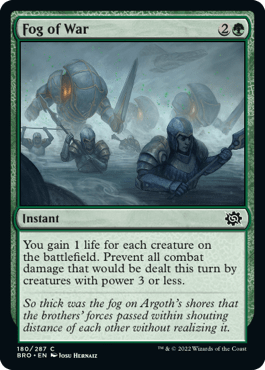
Keeper of the Cadence isn’t a well-statted creature for its cost, but it could be of use in preventing decking from self-mill. You could also try to build turbo fog with it and Union of the Third Path plus Fog of War!

Self-Assembler can grab any assembly-worker from your deck, not just extra copies of itself (Autonomous Assembler and each of the Urzatron commons are assembly-workers)!


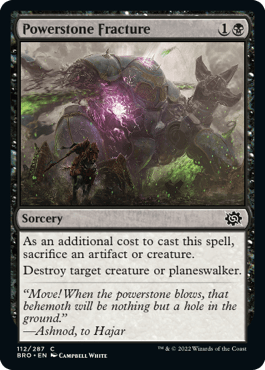

Chromatic Star and Ichor Wellspring are premium artifacts to sacrifice to Powerstone Fracture and Thraxodemon.

Disenchant and other cards that destroy artifacts seem great in this set, so pick them highly and don’t be afraid to start multiple copies.
Quick and Dirty Guide to Building a Prerelease Pool
You can do exactly what I'm doing below using Draftim's draft (and sealed) simulator absolutely for free:
- Open your pool and sort your cards by rarity/color.
- Note your bomb rares, multicolor cards, removal spells, fixing, and more.
- Note which of your colors is the deepest after removing weak cards like Fog of War, Military Discipline, and Union of the Third Path.
- Start laying out builds that play as many of your good cards/bombs/etc. as possible.
- If you have fixing, dig through your other colors and identify bombs and removal spells that might be worth splashing.
- Iterate your deck over and over trying to strike the perfect balance between mana curve, card advantage, bombs, removal, etc.
- Settle on a final product and battle it out!
Wrap Up
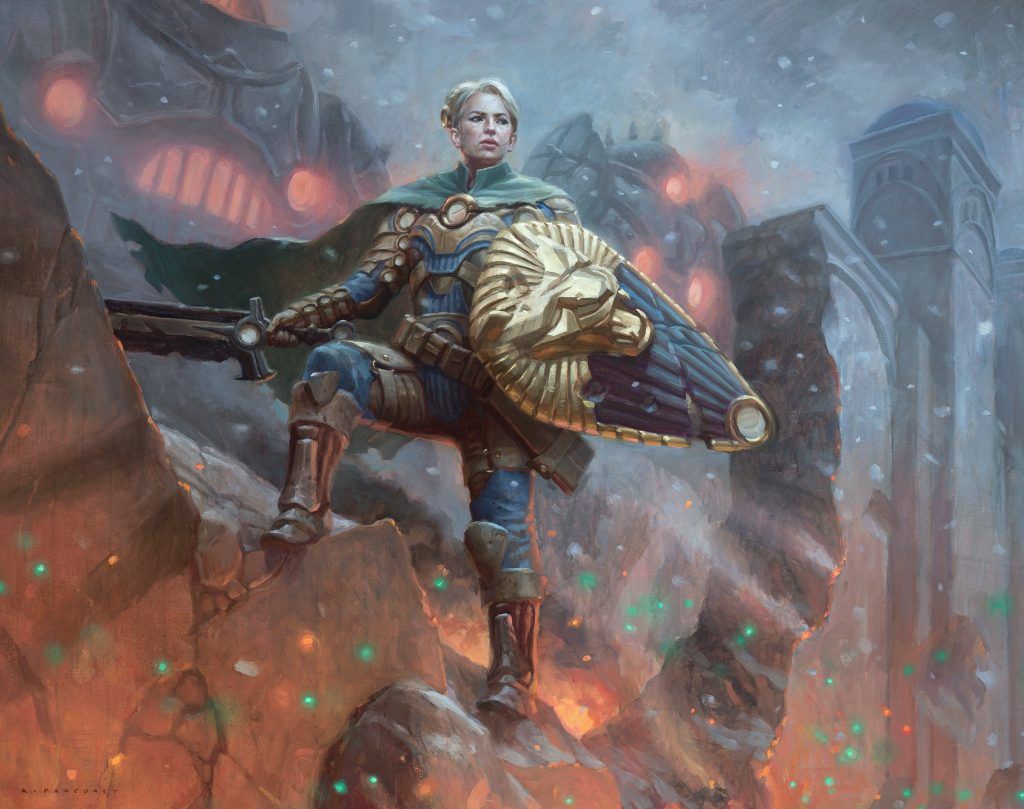
Myrel, Shield of Argive | Illustration by Ryan Pancoast
And with that we’ve reached the end of our The Brothers’ War prerelease guide! I wish you the best of luck this weekend with The Brothers’ War. Don’t forget that I’ll have the full Draft guide with extra tips and info soon too so that you can master this new Sealed format.
If you're playing sealed on MTG Arena, make sure you're using Draftsim's free app, Arena Tutor. It will scan your sealed pool and suggest which deck to build!
Until next time, may you be the only player at your prerelease to actually pull off a meld!
Follow Draftsim for awesome articles and set updates: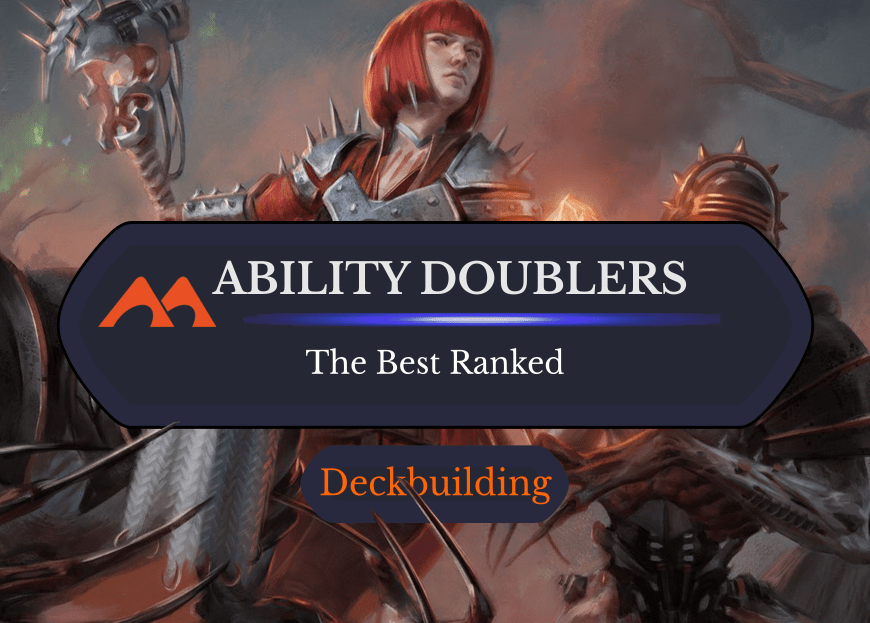
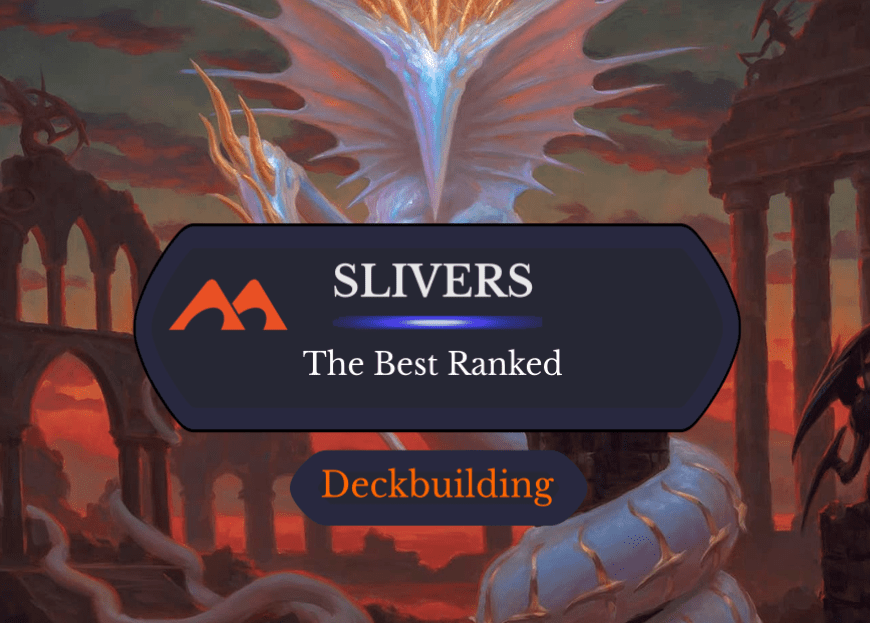
1 Comment
Mate, don’t forget mana sinks as a seriously important consideration when building your pool in this format, given the prevalence of powerstones.
Add Comment